the French Impressionists are an oasis in a gloomy Australia
- Written by Sasha Grishin, Adjunct Professor of Art History, Australian National University
Review: French Impressionism from the Museum of Fine Arts, Boston. NGV International
When prospects for overseas travel are bleak, a major exhibition of the work of the French Impressionists is a salvation — a beautiful shining oasis in a somewhat gloomy Australia.
When I lived in Cambridge Massachusetts, across the Charles River from Boston, the Museum of Fine Arts in Boston was an unexpected veritable treasure trove. Unexpected in that it is not as well known as some of the museums in New York, London or Paris.
But, with more than 450,000 art objects, it is the 14th largest art museum in the world and is famed for its collection of French Impressionism.
This “neglect” means, of the 100 works at this exhibition, about 80% have never before been seen in this country.
The exhibition sparkles with unexpected treasures including Edouard Manet’s Street singer (c1862), a huge vibrant life-size painting; Claude Monet’s luminous Poppy Field in a hollow near Giverny (1885); Paul Cézanne’s classic Fruit and a jug on a table (c1890–94) and the pulsating Vincent van Gogh, Houses at Auvers (1890).
 Paul Cézanne, French 1839–1906. Fruit and a jug on a table c.1890–94. Oil on canvas 32.4 x 40.6 cm.
Museum of Fine Arts, Boston Bequest of John T. Spaulding Photography © Museum of Fine Arts, Boston. All Rights Reserved
Paul Cézanne, French 1839–1906. Fruit and a jug on a table c.1890–94. Oil on canvas 32.4 x 40.6 cm.
Museum of Fine Arts, Boston Bequest of John T. Spaulding Photography © Museum of Fine Arts, Boston. All Rights Reserved
The accessibility of Impressionism
The National Gallery of Victoria’s Winter Masterpieces series of exhibitions commenced in 2004 with the exhibition Impressionists: Masterpieces from the Musée d'Orsay. There were then exhibitions of Monet (2013), Degas (2016) and Van Gogh (2017).
Impressionism has certainly been a unifying thread of the Winter Masterpieces series. These four exhibitions have attracted almost a million visitors between them.
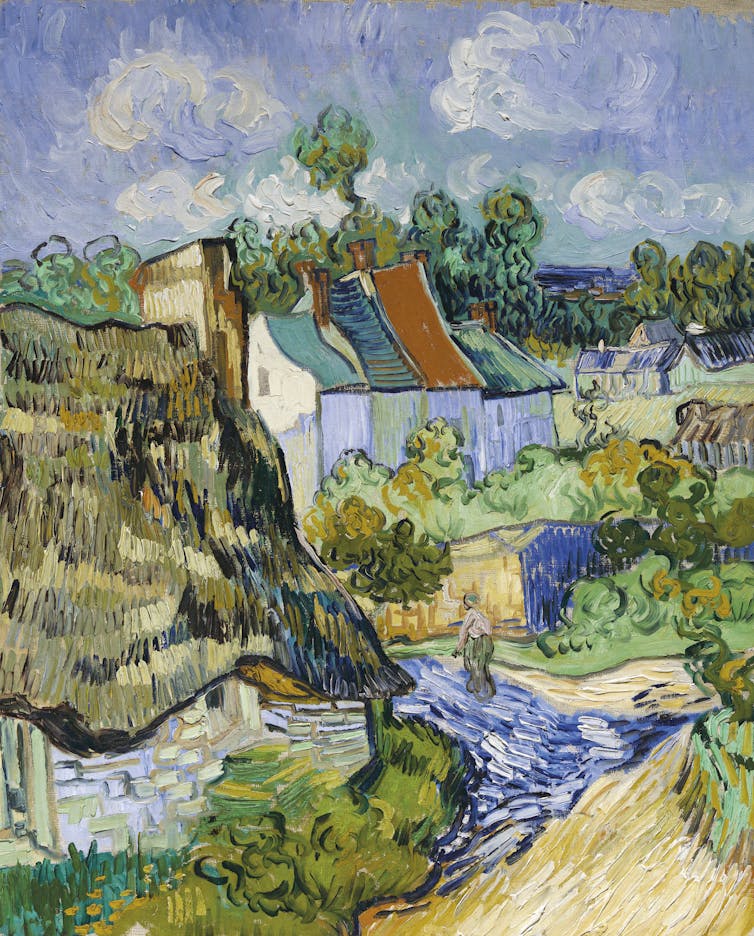 Vincent van Gogh, Dutch (worked in France) 1853–90. Houses at Auvers 1890. Oil on canvas, 75.6 x 61.9 cm.
Museum of Fine Arts, Boston Bequest of John T. Spaulding Photography © Museum of Fine Arts, Boston. All Rights Reserved
Vincent van Gogh, Dutch (worked in France) 1853–90. Houses at Auvers 1890. Oil on canvas, 75.6 x 61.9 cm.
Museum of Fine Arts, Boston Bequest of John T. Spaulding Photography © Museum of Fine Arts, Boston. All Rights Reserved
What is it about Impressionism that makes it the most popular art movement amongst the general public? In part, it is because it is such an accessible and undemanding art language.
There is no demand made on the viewer to decipher the complexities of mythology — the naked gods in complicated embraces — and the subject matter deals with a reality known and experienced by many in their audience. There is a celebration of a physically accessible countryside; of a hedonistic lifestyle with pretty girls and handsome young men frolicking, flirting and enjoying parties, spending a day at the races or travelling to beauty spots abroad.
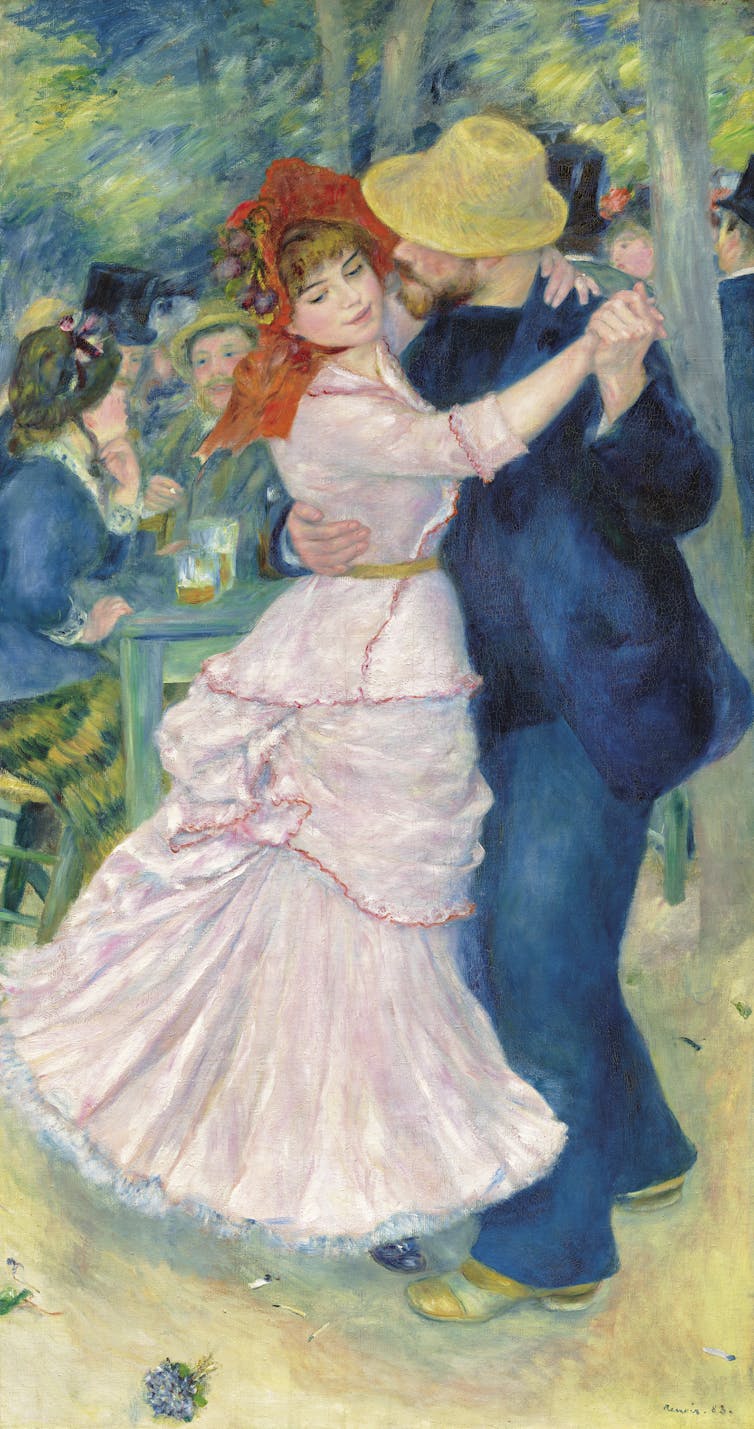 Pierre Auguste Renoir, French 1841–1919. Dance at Bougival 1883. Oil on canvas 181.9 x 98.1 cm.
Museum of Fine Arts, Boston Picture Fund Photography © Museum of Fine Arts, Boston. All Rights Reserved
Pierre Auguste Renoir, French 1841–1919. Dance at Bougival 1883. Oil on canvas 181.9 x 98.1 cm.
Museum of Fine Arts, Boston Picture Fund Photography © Museum of Fine Arts, Boston. All Rights Reserved
Pierre-Auguste Renoir’s Dance at Bougival (1883), an icon image for this exhibition, shows a man eating up the woman in his arms on the dancefloor, while companions sit at tables drinking and sharing the cheer. There is a palpable feeling of a joyous letting go, and celebrating.
You can almost hear the dance music radiating from the picture.
In part, the popularity of Impressionism must lie in the new way of painting with the brighter and more luminous palette, generally the broken, roughly applied brush strokes and the move of the whole colour scheme away from the dark tonal masses to vibrant heightened colour reflexes.
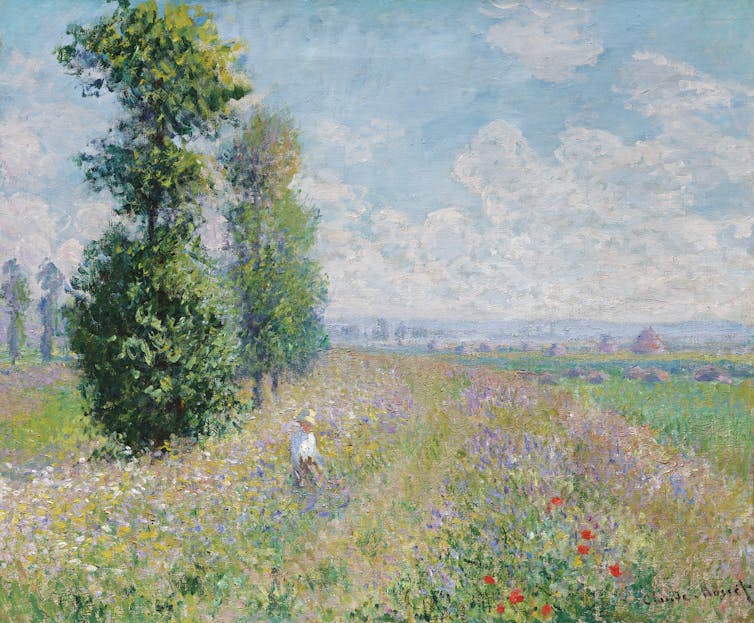 Claude Monet, French 1840–1926. Meadow with poplars c. 1875. Oil on canvas 54.6 x 65.4 cm.
Museum of Fine Arts, Boston Bequest of David P. Kimball in memory of his wife Clara Bertram Kimball. Photography © Museum of Fine Arts, Boston. All Rights Reserved
Claude Monet, French 1840–1926. Meadow with poplars c. 1875. Oil on canvas 54.6 x 65.4 cm.
Museum of Fine Arts, Boston Bequest of David P. Kimball in memory of his wife Clara Bertram Kimball. Photography © Museum of Fine Arts, Boston. All Rights Reserved
This applies equally to Camille Pissarro’s light and breezy Spring pasture (1889) or the radiating Claude Monet’s Meadow with poplars (c1875). By classical standards, the works appear “unfinished” or impressions of scenes, instead of the carefully composed and compositionally resolved views with their mirror-like finishes.
Berthe Morisot’s White flowers in a bowl (1885) or Monet’s Grand Canal, Venice (1908) sit on the canvas like a sketch breathing with life and light and appear immediate and accessible.
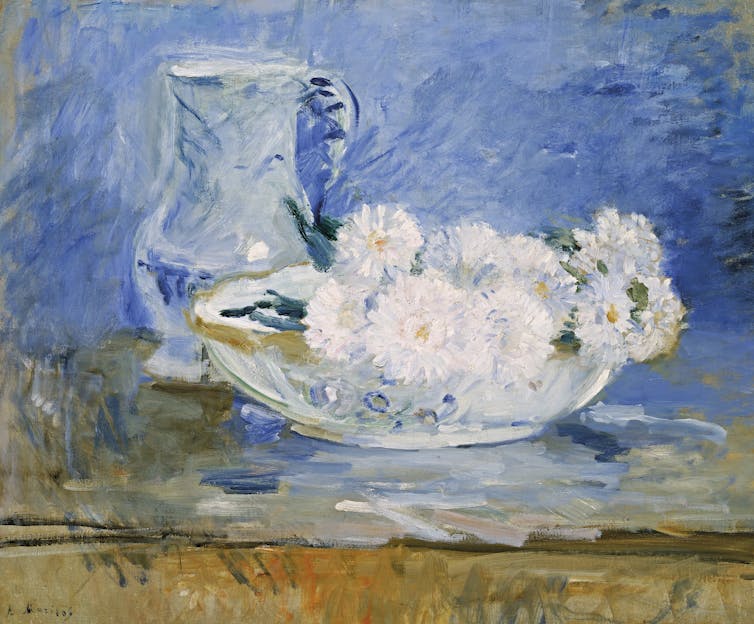 Berthe Morisot, French 1841–95. White flowers in a bowl 1885. Oil on canvas 46.0 x 55.0 cm.
Museum of Fine Arts, Boston Bequest of John T. Spaulding Photography © Museum of Fine Arts, Boston. All Rights Reserved
Berthe Morisot, French 1841–95. White flowers in a bowl 1885. Oil on canvas 46.0 x 55.0 cm.
Museum of Fine Arts, Boston Bequest of John T. Spaulding Photography © Museum of Fine Arts, Boston. All Rights Reserved
The iconic and the forgotten
Particularly when Impressionism is interpreted in the very broad sense of the word, as it is in this exhibition to include much of what immediately preceded it, Impressionism attracted some of the best painters over several generations.
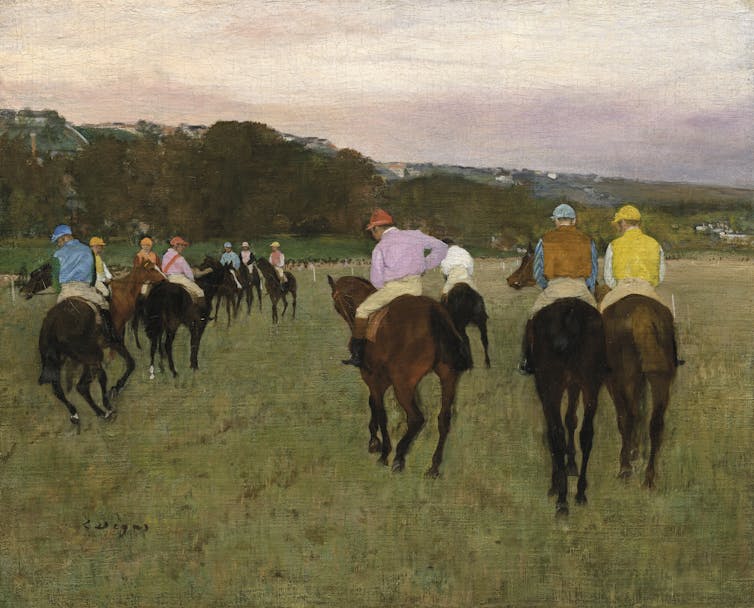 Edgar Degas, French 1834–1917. Racehorses at Longchamp 1871, possibly reworked in 1874. Oil on canvas, 34.0 x 41.9 cm.
Museum of Fine Arts, Boston S. A. Denio Collection—Sylvanus Adams Denio Fund and General Income. Photography © Museum of Fine Arts, Boston. All Rights Reserved
Edgar Degas, French 1834–1917. Racehorses at Longchamp 1871, possibly reworked in 1874. Oil on canvas, 34.0 x 41.9 cm.
Museum of Fine Arts, Boston S. A. Denio Collection—Sylvanus Adams Denio Fund and General Income. Photography © Museum of Fine Arts, Boston. All Rights Reserved
This show includes some of the greats in realism such as Gustave Courbet, a good selection of Eugène Louis Boudin, the wonderful tonal landscapes of Jean-Baptiste-Camille Corot, a cross-section of the Barbizon School of landscape painters, right through to Edgar Degas, Alfred Sisley, Monet, van Gogh and Henri de Toulouse Lautrec.
It is a very strong show that combines famous iconic images by some of the great names, such as Monet’s much reproduced and discussed Grainstack (snow effect) (1891) and his water lilies series, with some quirky and puzzlingly neglected works, including Gustave Caillebotte’s Man at his bath (1884).
 Claude Monet, French 1840–1926. Grainstack (Snow effect) 1891. Oil on canvas, 65.4 x 92.4 cm.
Museum of Fine Arts, Boston. Gift of Miss Aimée and Miss Rosamond Lamb in memory of Mr. and Mrs. Horatio Appleton Lamb. Photography © Museum of Fine Arts, Boston. All Rights Reserved
Claude Monet, French 1840–1926. Grainstack (Snow effect) 1891. Oil on canvas, 65.4 x 92.4 cm.
Museum of Fine Arts, Boston. Gift of Miss Aimée and Miss Rosamond Lamb in memory of Mr. and Mrs. Horatio Appleton Lamb. Photography © Museum of Fine Arts, Boston. All Rights Reserved
This Boston Impressionists show, on one hand, caters for a popular audience with a display of some of quintessential “masterpieces” of French Impressionism that will find a ready resonance with any viewer seeking an escapist orgy of sunlight, colour and hedonism.
On the other hand, it is also intended for the very erudite viewer, who can be inducted into the complex nuances and states of Pissarro’s etchings or into Boudin’s profound explorations of colour and mood.
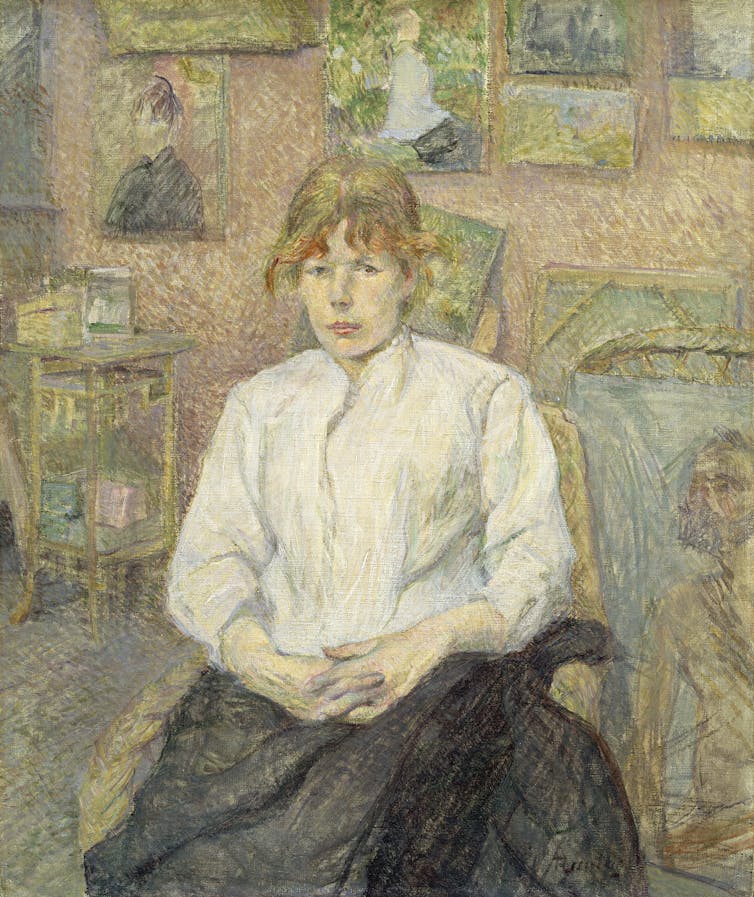 Henri de Toulouse-Lautrec, French 1864–1901. Carmen Gaudin in the artist’s studio 1888. Oil on canvas 55.9 x 46.7 cm.
Museum of Fine Arts, Boston Bequest of John T. Spaulding Photography © Museum of Fine Arts, Boston. All Rights Reserved
Henri de Toulouse-Lautrec, French 1864–1901. Carmen Gaudin in the artist’s studio 1888. Oil on canvas 55.9 x 46.7 cm.
Museum of Fine Arts, Boston Bequest of John T. Spaulding Photography © Museum of Fine Arts, Boston. All Rights Reserved
Even as COVID clouds gather once more over Australia, French Impressionism from the Museum of Fine Arts, Boston is almost guaranteed to become a blockbuster exhibition success.
It will assist us in better understanding the Australian Impressionism exhibition presently on show at NGV Australia, and further our love affair with Impressionism.
Read more: She-Oak and sunlight: 'the best feelgood show I have seen since COVID'
French Impressionism from the Museum of Fine Arts, Boston is at NGV International until October 3
Authors: Sasha Grishin, Adjunct Professor of Art History, Australian National University





